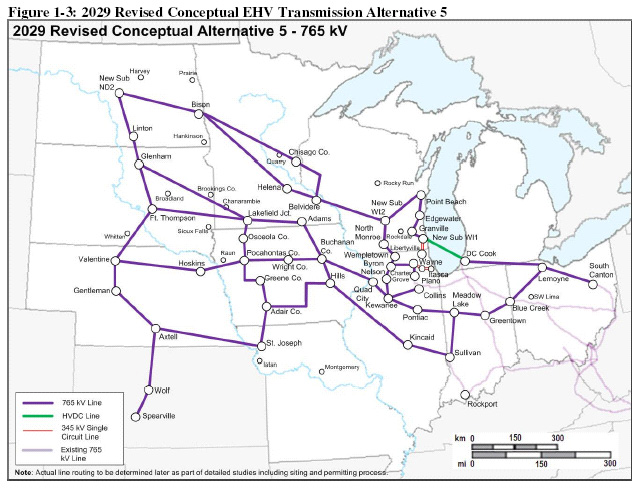East Coast Governors STAND UP AGAIN!
July 13th, 2010
YEAAAAAAAA! The East Coast Governors are mad as hell and letting the Senate know just what they think of this Midwest plan to build billions and billions of dollars of transmission from here to the East Coast and make them pay for it, oh yes, it’s about time the Midwest schemers start listening.
The Des Moines Register is paying attention — why not Minnesota papers?
And here’s the letter itself, pretty much the same spirit as the last one, although I don’t see the directly stated link to coal in this one:
Here’s a pithy snippet:
This comes not too far on the heels of some promotional announcements about those transmission plans, the “not so” SMARTransmission study — I though I’d posted this before, but don’t see it, so here it is:
How’s this for a vision/nightmare — it’s one of their chosen three:
CATF wants federal PPA?
July 12th, 2010
Oh, how bizarre can it get. Sometimes, I’m left speechless in disbelief. We all know about Clean Air Task Force’s toadying for coal, they’re the Clean Air Task FArce, but this? It’s just going too far.
CLEAN AIR TASK FORCE THINKS THE FEDS SHOULD SIGN A PPA FOR FUTUREGEN ELECTRICITY!
Really, here’s a quote from the Press Release:
And I’m sure that Tom Micheletti, of Excelsior Energy/Mesaba Project infamy, is not happy about this, not happy about it because they’re proposing the FutureGen and not Mesaba:
IGCC plants have problems getting Power Purchase Agreements because they are NOT economical, even with all the federal and state subsidies, with all the perks, with all the circumvention of regulation, as the ALJ’s noted in their Recommendation to the PUC on the Mesaba Project PPA, it’s just TOO COSTLY! And, plus, it’s NOT in the public interest!
But there goes Clean Air Task Farce saying the feds, US, we the taxpayers, should buy up the FutureGen electricity? Give me a break! Really, here it is from the horse’s mouth(the other end of the horse is further below) — this CATF press release just out:
REPORT CALLS FOR COMPREHENSIVE ARRAY OF NEW DEMONSTRATION PLANTS, $20 BILLION IN NEW FUNDING
Here’s the entire CATF report:
Contact the White House, Executive Office of the President, and tell the staff what you think of CATF’s brilliant idea and what you think of CATF’s lobbying for coal:
And this article about it:
Expert: Feds should buy FutureGen’s power output
Poop Power in the WSJ
July 12th, 2010
Fibrowatt in the Wall Street Journal?
I would think that Minnesota’s experience with burning chicken shit would wake up the world. How is it that so many states had the sense to run Fibrowatt right out of town, Alan Muller & Green Delaware led the charge in Delaware, and just recently, Fibrowatt was run out of North Carolina. He’s been digging into their file at the MPCA, it’s intense, he spent a LOT of time in the basement file room, got piles of papers and a disc or two, and he got a copy of the agreement after it came out:
FYI, here’s the PPA from November 2000 – I believe it’s been ratcheted up since:
To review the Minnesota Public Utilities Commission file on Fibrominn go to www.puc.state.mn.us and “Search eDockets” and search for docket “00-1169.” The compliance filings are redacted, so the comparisons between Fibrominn, Laurentian, and District Energy in the most recent filing that would be so enlightening, isn’t… DRAT!
What’s Minnesota’s experience with Fibrowatt/Fibrominn:
Contact: Forrest Peterson, 320-441-6972 Willmar, Minn. — The Minnesota Pollution Control Agency (MPCA) and Fibrominn of Benson reached an agreement recently resolving the company’s past failure to comply with state air-quality rules and permit conditions. Air emission violations occurring since 2007 resulted in a $65,000 penalty, and corrective actions including the installation of a new sulfur dioxide monitor at a minimum cost of $80,000. Fibrominn began operation in May 2007 burning primarily turkey litter to generate electricity. Since the start of operations, the facility has experienced numerous violations of its permit. The settlement addresses violations of late report submittals, failed performance test, and excess nitrogen oxide, sulfur dioxide and carbon monoxide emissions. The company also failed to self-report deviations that occurred during operation of the facility’s poultry litter-fired boiler. Fibrominn has since conducted the performance test and submitted a testing frequency plan, a continuous opacity monitor/continuous emissions monitor downtime elimination report, a pressure drop limit, a relative accuracy test audit test plan, a hydrochloric acid correlation curve and a permit compliance checklist. Minnesota law requires owners and operators of facilities with the potential to release air pollutants to have MPCA permits. Facilities must also carefully monitor and maintain equipment because emissions exceeding state standards can degrade air quality. The MPCA offers outreach and training to help facilities meet their permit requirements. For more information on air quality permits and emission standards, call Jennifer Lovett, MPCA air quality inspector, at 651-757-2538 or 1-800-657-3864. A stipulation agreement such as this is one of the tools used to achieve compliance with environmental laws. When calculating penalties, the MPCA takes into account how seriously the violation affected the environment, whether it is a first-time or repeat violation and how promptly the violation was reported to appropriate authorities. It also attempts to recover the calculated economic benefit gained by failure to comply with environmental laws in a timely manner. For a comprehensive list of enforcement actions by the MPCA, go to the agency’s Web site at www.pca.state.mn.us/newscenter/enforcement.html.
Here’s a link to Jim Turner’s blog digging into it when confronted with a proposal nearby in Page County, VA:
Where they were run out again:
But then we have yahoos like Delaware’s Senator Carper who just can’t seem to bend over far enough despite so much evidence on what a piss-poor idea poop power is:
So what’s Fibrowatt up to?
Back to the beginning, the article about Fibrowatt in today’s Wall Street Journal that means Fibrowatt is gearing up for another assault on some unsuspecting or uncaring state, with this about their plant here in Minnesota:
Here’s the full article:
Looking to Litter
Energy Company Sees a Future in Chicken Manure
Many farmers use chicken litter—a mixture of manure and bedding—as a fertilizer, either spreading it on their own croplands or selling it to other growers. But the litter increasingly is being blamed for phosphorus-laden runoff that chokes waterways in heavy poultry-producing areas, and environmentalists are pushing the federal government to set limits on its use.
Read the rest of this entry »
SMART transmission? I don’t think so…
July 6th, 2010
There’s a piece in Finance & Commerce that should not go unnoticed:
Oh how depressing, can it be? Things have been bubbling up, but I figured they’d get their corporate heads screwed on straight and figure out it’s not needed and it would go away. Silly moi!
Here’s their site:
www.smartstudy.biz
Geiger’s report puts Xcel Energy in the drivers’ seat, but what I see is a list of the biggest coal companies around:
I’ll update this some more tomorrow — this is making me nauseous…
Byron Starns on both sides of the fence
July 6th, 2010
I’ve just by utter accident discovered a few things…
We all remember Byron Starns, attorney for Excelsior Energy’s Mesaba Project, the coal gasification project from hell. Check his bio – CLICK HERE – he’s done some amazing things, that Reserve Mining case in particular.
Now let’s take a walk back on memory lane, the 2003 Prairie Island bill, where the “Environmental Coalition”, i.e., Izaak Walton League, MCEA, ME3/Fresh Energy, and Xcel and Tom Micheletti did a deal that advance wind some, let Xcel continue using Prairie Island and increased cask storage, and opened the door for Micheletti’s Excelsior Energy and their IGCC plant that they’d been promoting since the 2002 session. On one hand, the “Environmental Coalition” including MCEA, in the middle we have Xcel, and on the other we have Tom Micheletti and Excelsior Energy…
Here’s the 2003 Prairie Island bill:
Minnesota Session Laws 2003 – 1st Special Session, Chapter 11
Here’s what it did for Mesaba (as if calling burning garbage “renewable” wasn’t enough):
Excelsior Energy Mesaba Project related parts of 2003 Chapter 11
When the Power Purchase Agreements for Excelsior Energy’s Mesaba Project came up at the PUC, MCEA intervened, both as a party and representing others:
To look at the full docket, go to www.puc.state.mn.us and “Search Dockets” and search for PPA docket “05-1993” and Siting docket “06-668.”
And look who filed a Notice of Appearance for Excelsior Energy dated April 27, 2006:
And representing Excelsior Energy in the Siting Docket dated September 26, 2006:
And look who is noted in the MCEA Annual Reports as providing legal services to MCEA in 2005 and 2006, look in the fine print, why it’s Byron Starns!
Oh, but that’s not all, look who joins the Board of MCEA in 2007 … and remains through 2008… and 2009 according to his bio on the LSD site — why, it’s Byron Starns again!:
Board of Directors, Minnesota Center for Environmental Advocacy, 2007–2009 (linked)
His bio states he was on the MCEA board in 2009, but the 2009 IRS 990 does not list him as having been on it at reporting year end.
I just spoke with Byron Starns, who, with the forwarning to don his Kevlar vest, was kind enough to entertain a few questions, and said that (close to quotes but not quite):
MCEA has an ethical requirement, that everyone on the Board must make full disclosure of interests and conflicts, and that when issues do come up, anyone with a conflict has to leave the room. He said he didn’t participate in any decisions related to energy matters for MCEA. He does not recall if the fact that he was on MCEA’s board was disclosed in the Excelsior Energy Mesaba Project PPA or Siting dockets. Also, he noted he is no longer on the Board of MCEA.
I don’t recall any disclosure about this — do you?
Is it “not a conflict” because MCEA’s interests and the interests of their “clients” the Waltons and Fresh Energy are so closely aligned with those of Excelsior Energy because of that 2003 agreement?





